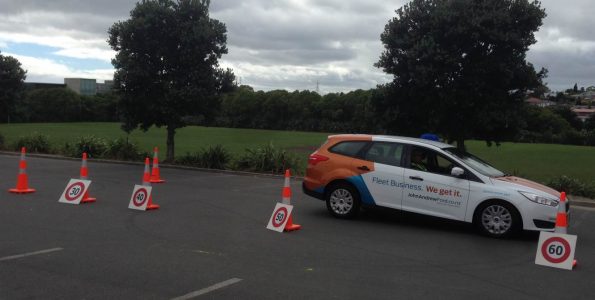One of the biggest causes of accidents is people braking too late. When we look at the road we are constantly scanning for hazards, but once we see something our brain has to process it against a set of likely outcomes. The more experience we have of driving, the quicker we can do this. Then we hit the brake. This delay between seeing the hazard and getting our right foot from the accelerator to the brake is called reaction time.
To see the amount of impact reaction time makes we can calculate how far we travel during the reaction time. An average human takes around 1.5 seconds to react. At 50km/h we are travelling almost 14 metres per second, therefore we travel 21m. However, in a modern car it takes hardly any distance to stop.

A braking test using a new Ford Fiesta with anti-lock brakes in a car park in New Zealand. This is just the braking distance and doesn’t include reaction time.
You can see in the image above that you can stop from 30km/h in less than the length of the car, 40km/h in about the length of the car (4.5m), 50km/h in around twice the length of the car (9m) and 60km/h in three times the length of the car (13.5m).
Therefore the reaction time is huge – at 50km/h the reaction time is more than twice the stopping distance.
If we could reduce or even eliminate reaction time we would save a lot of injuries.
Forward collision warning
Forward collision warning (FCW) is when a vehicle gives you and audible and/or visual warning that you need to brake.
Forward collision warning is good for a distracted driver as it brings their attention to the unfolding hazard and allows them to react.
Automatic emergency braking
Automatic emergency braking takes this one step further. Automatic emergency braking (AEB) gives you an audible, visual and/or tactile warning you should brake, and if you don’t, it applies the brakes for you.
Automatic emergency braking is good for a distracted driver and also good for a driver that might experience a situation he’s not familiar with, or a situation where another motorist is causing an unavoidable hazard. In these cases, the AEB might not necessarily stop the car completely before an impact, but it will dramatically reduce how severe that impact is by applying the brakes much sooner.
Any car with AEB will also have brake assist and electronic brakeforce distribution. Brake assist applies full braking power when an emergency braking situation is detect. Electronic brakeforce distribution makes sure the maximum braking power goes to all four wheels.
AEB-equipped cars often have adaptive cruise control, too, as a similar mechanism is used.
Sensors and cameras
FCW and AEB can only work with sensors and/or cameras to detect what is going on in front of the car. They look at the trajectory and size of objects approaching your car and calculate whether you could stop on a dry road.
Radar/lidar sensors are usually in the bumper or grille, while cameras are usually behind the windscreen next to the rear-view mirror.
Why don’t AEB and FCW work all the time?
AEB and FCW cannot predict much more than 50-100m ahead. 50m is less than the braking distance from 100km/h, and is the distance you travel in two seconds at 100km/h. A good driver can look 10-12 seconds up the road and anticipate developing hazards and react to them much sooner than an electronic intervention (really, just a last resort). AEB and FCW let you know if something is an immediate threat, but in most cases the driver has a lot of power to avoid these situations just by looking further ahead.
AEB and FCW do not work as well on wet or slippery roads where braking distances are longer. This could be programmed into them if they were connected to automatic wipers, but that is only for when it’s raining, not for when the road is wet but it’s not raining.
Camera-based systems do not work well in fog and heavy rain; radar-based systems are more reliable.
Some systems only work within certain speed ranges.
Some types of intentional manoeuvres by the driver can trigger the system, e.g. some configurations of intersections when vehicles are pulling out safely into another lane, or when you accelerate and change lanes to overtake.
What is AEB most useful for?
AEB makes it much less likely you will have a nose-to-tail accident.
The systems are installed in trucks as well as cars, and you can see the in-cab experience from 0:42 in the following video.
